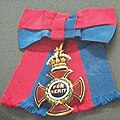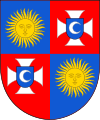
A cross pattée, cross patty or Pate, or cross paty, also known as a cross formy or cross formée (French: croix pattée, German: Tatzenkreuz) or Templar cross, is a type of Christian cross with arms that are narrow at the centre, and often flared in a curve or straight line shape, to be broader at the perimeter. The form appears very early in medieval art, for example in a metalwork treasure binding given to Monza Cathedral by Lombard queen Theodelinda (died 628), and the 8th-century lower cover of the Lindau Gospels in the Morgan Library. An early English example from the start of the age of heraldry proper (i.e. about 1200) is found in the arms of Baron Berkeley.
Etymology
The word pattée is a French adjective in the feminine form used in its full context as la croix pattée, meaning literally "footed cross", from the noun patte, meaning literally foot, generally that of an animal. The cross has four splayed feet, each akin to the foot, for example, of a chalice or candelabrum. In German it is called Tatzenkreuz from Tatze, foot, paw. Planché provides a dubious suggestion that the term comes from the Latin verb pateo, to lie open, be spread. He states it to be discernible on the standard of King Stephen (1135–1154).
Variants
Several variants exist as follows:
| Image | Description |
|---|---|
 |
With the edges of the arms concave throughout. Best known for its use as the Iron Cross, based on the Leechkirche [de] of the Teutonic Order (image), used as a symbol of the German Empire that was present in its War Ensign and war materiel, including on Luftstreitkräfte aircraft until April 1918 when the Balkenkreuz was introduced. |
 |
A cross pattée with a sharp point added to the lower limb, as if for use in staking into the ground, but used to represent a sword in the Cross of Saint James (also known as "sword cross"). |
 |
With less curvature, used on Luftstreitkräfte aircraft until April 1918, and the basis for the similar cross used by the armed forces of modern Germany, the Bundeswehr. |
 |
Bolnisi cross, official national symbol of the republic of Georgia, used on flag, coat of arms and various official and unofficial organizations of this country. |
 |
With the ends of the arms convex and curved; sometimes called cross alisée (French: croix pattée alésée arrondie, lit. 'rounded reamed patté cross'). |
 |
With triangular arms which come close to filling a square. One example is an artistic variant of the cross pattee components in the Sancroft arms, seen thrice in the ecclesiastical coat of arms of William Sancroft (1617-93), Archbishop of Canterbury in a mid-1740s stained glass at St Lawrence's Church, Mereworth. |
 |
With triangular arms that do not fill the square, used on flag, coat of arms and various medals, also known as the Saint George's Cross in Sweden and the Cossack cross in Ukraine. |
 |
With straight parallel lines at the centre, it still fits the general definition of "having branches that widen by curving at their ends", and is considered pattée in Rudolf Koch's The Book of Signs (German: Das Zeichenbuch). |
Use in crowns
Many crowns worn by monarchs have jewelled crosses pattées mounted atop the band. Most crowns possess at least four such crosses, from which the half arches rise. Some crowns are designed so that the half-arches can be detached, allowing the circlet to be worn separately on occasion.
A cross pattée is particularly associated with crowns in Christian countries. It is often heavily jewelled, with diamonds and precious stones. The Koh-i-Noor diamond is set in a cross pattée on the Crown of Queen Elizabeth the Queen Mother. The British Imperial State Crown has a base of four crosses pattée alternating with four fleurs-de-lis. A cross pattée on the Imperial State Crown holds the Black Prince's Ruby. The cross pattée also features in many of the other British Crowns including the St Edward's Crown, used for coronations, and the Imperial Crown of India created for George V as Emperor of India to wear at the Delhi Durbar of 1911.
Use by Crusaders, Prussia, and Germany
Teutonic Knights
This cross is often associated with the Crusades. The heraldic cross pattée was sometimes used by the Teutonic Knights, a Crusader order, though their more usual emblem was a plain straight black cross on white field..
-
 Emblem of the Teutonic Order
Emblem of the Teutonic Order
Iron Cross
In 1813, King Frederick William III of Prussia established the Iron Cross as a decoration for military valor, and it remained in use, in various forms, by Prussia and later Germany until 1945. A stylized version of the Iron Cross is used to date by the German army (Bundeswehr) as its symbol of nationality, and is found on vehicles, aircraft and publications.
Prussian and Imperial German Landwehr and Landsturm troops used a Cross Pattée cap badge to distinguish them from regular army troops. A stylized version of the Cross Pattée is used by the modern German military as its symbol of nationality, and is found on vehicles, aircraft and publications, with no border of any kind at the ends of each arm (as was the case with the Balkenkreuz used on German aircraft in 1918-1945).
-
 German Iron Cross, World War I
German Iron Cross, World War I
-
 Modern Bundeswehr emblem
Modern Bundeswehr emblem
Modern usage
Belarus
The cross pattée is adopted in several municipal coats of arms of Belarus.
Canada
The cross pattée, a traditional Royal symbol in Canada, has been incorporated into official national symbols, provincial symbols and the insignia of various national armed forces. The Arms of Canada, numerous provincial coat of arms and the badges of the Canadian Forces feature St Edward's Crown; that displays four cross pattée and four fleur-de-lys, supporting two dipped arches topped by a monde and another cross pattée. Numerous orders, decorations, and medals of Canada are designed with a cross pattée, including the nation's highest civilian honour, the Order of Merit and the Victoria Cross of Canada the highest military honour that is derived from that of the British original Victoria Cross.
France
The cross pattée can be found on coats of arms of various French communes.
-
 Coat of arms of Ambacourt
Coat of arms of Ambacourt
-
 Coat of arms of Damouzy
Coat of arms of Damouzy
-
 Coat of arms of Fontaine-lès-Luxeuil
Coat of arms of Fontaine-lès-Luxeuil
-
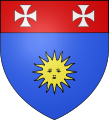 Coat of arms of Fontaines-Saint-Martin
Coat of arms of Fontaines-Saint-Martin
-
 Coat of arms of Saint-Gondon
Coat of arms of Saint-Gondon
Georgia
Main article: Bolnisi crossThe Bolnisi cross (Georgian: ბოლნისის ჯვარი bolnisis ǰvari) is a cross symbol, taken from a 5th-century ornament at the Bolnisi Sioni church, which came to be used as one of the oldest national symbol of Georgia. It was used on the flags and coat of arms of the Kingdom of Georgia and the current Republic of Georgia, with its various organizations and administrative divisions.
-
Bolnisi Sioni inscriptions. Oldest Georgian inscription that uses the Asomtavruli script, predating the modern Mkhedruli script, inside Georgia.
-
 Flag of Georgia
Flag of Georgia
-
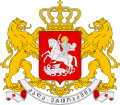 Coat of arms of Georgia
Coat of arms of Georgia
-
 Roundel of the Georgian Defense Forces
Roundel of the Georgian Defense Forces
-
 Coat of arms of the city of Bolnisi
Coat of arms of the city of Bolnisi
Latvia
-
 Coat of arms of the Brotherhood of Blackheads shown in the House of the Blackheads, Riga
Coat of arms of the Brotherhood of Blackheads shown in the House of the Blackheads, Riga
-
 Coat of arms of Riga
Coat of arms of Riga
-
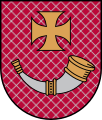 Coat of arms of Ventspils
Coat of arms of Ventspils
Montenegro
Main article: Flag of MontenegroThe Montenegrin cross-flag (Krstaš-barjak) has been used in Montenegro since medieval times to represent the state, and lately its military divisions. Use of this flag was first recorded in 1687. During the 1990s, it was used as a symbol of Montenegrin independence movement, most notably by the Liberal Alliance of Montenegro. Nowadays, Montenegro's Royal Capital City Cetinje uses krstaš flag as its flag. It is also used as an unofficial alternate Montenegrin flag, as well as by local trademarks and societies related to Montenegro.
-
 Flag of the Prince-Bishopric of Montenegro
Flag of the Prince-Bishopric of Montenegro
-
 Montenegrin flag used in the Battle of Vučji Do. The Н.I. initials indicate Prince Nicholas I. One of the most important historical Montenegrin flags.
Montenegrin flag used in the Battle of Vučji Do. The Н.I. initials indicate Prince Nicholas I. One of the most important historical Montenegrin flags.
-
 Flag of Old Royal Capital Cetinje
Flag of Old Royal Capital Cetinje
-
 Coat of arms of Nikšić Municipality
Coat of arms of Nikšić Municipality
-
 Modern Montenegrin Air Force roundel
Modern Montenegrin Air Force roundel
-
 Montenegrin Police Special Counter-Terrorist Unit Insignia
Montenegrin Police Special Counter-Terrorist Unit Insignia
-
 Flag of Montenegrins of Serbia
Flag of Montenegrins of Serbia
-
 Order of Prince Danilo I
Order of Prince Danilo I
Poland

-
 Coat of arms of Podkarpackie Voivodeship
Coat of arms of Podkarpackie Voivodeship
-
 Coat of arms of Przemyśl
Coat of arms of Przemyśl
-
 Coat of arms of Rzeszów
Coat of arms of Rzeszów
-
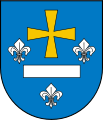 Coat of arms of Skierniewice
Coat of arms of Skierniewice
Portugal
Main article: Order of Christ CrossThe Portuguese heraldry makes a very common use of three variants of the cross pattée, the standard form (also as a variant of the Maltese cross proper, associated with the Knights Hospitaller), the Alisee form (associated with the Knights Templar) and the Order of Christ cross (associated with this order of chivalry and also used as one of the main national symbols of Portugal). These crosses are often present on the arms of the municipalities located in former domains of these orders.
-
 Coat of arms of Paços de Ferreira
Coat of arms of Paços de Ferreira
-
 Coat of arms of Madeira
Coat of arms of Madeira
-
 Roundel of the Portuguese Air Force
Roundel of the Portuguese Air Force
Russia
The cross pattée is adopted by Russian Border Service, it is also found on coats of arms of some Russian regions.
-
 Emblem of the Border Service
Emblem of the Border Service
-
 Coat of arms of Kaliningrad
Coat of arms of Kaliningrad
-
 Coat of arms of Kirov Oblast
Coat of arms of Kirov Oblast
-
 Coat of Arms of Perm Krai
Coat of Arms of Perm Krai
-
 Coat of arms of Borisovka, Belgorod Oblast
Coat of arms of Borisovka, Belgorod Oblast
The cross alisée version of the cross pattée, with rounded edges, has been used in Russia since the 19th century. This cross shape was used in the badges of the Narodnoe Opolcheniye, during the Patriotic War of 1812 and the Crimean War as well as the Aleksandrovskoe Military School [ru]. Although it was not used for decorations before, in the modern-day Russian Federation, the cross alisée was adopted for the Order of Courage, as well as for other emblems such as the logo of the Wagner Group.
-
 Narodnoe Opolcheniye badge, 1903 version
Narodnoe Opolcheniye badge, 1903 version
-
 Order of Courage
Order of Courage
-
 Medal "For Bravery" [ru]
Medal "For Bravery" [ru]
-
 Medal "For Life Saving"
Medal "For Life Saving"
Spain
-
 Coat of arms of El Bierzo
Coat of arms of El Bierzo
-
 Coat of arms of Mondoñedo
Coat of arms of Mondoñedo
-
 Coat of arms of Morcín
Coat of arms of Morcín
-
 Coat of arms of Oviedo
Coat of arms of Oviedo
-
 Coat of arms of Priorat
Coat of arms of Priorat
-
 Coat of arms of Sabiñánigo
Coat of arms of Sabiñánigo
-
 Coat of arms of Sitges
Coat of arms of Sitges
-
 Coat of arms of Villafáfila
Coat of arms of Villafáfila
Sweden
In Sweden, the term "Saint George's Cross" sometimes refers to the cross pattée used by Swedish Freemasons. For example, the cross of the Swedish Order of Freemasons was defined by the King of Sweden in 1928 to be a "red St George's cross with triangular arms".
-
 Flag of the Swedish Order of Freemasons
Flag of the Swedish Order of Freemasons
-
 Coat of arms of the Swedish Order of Freemasons
Coat of arms of the Swedish Order of Freemasons
Ukraine
In Ukraine, the "cossack cross" was used historically in banners by cossacks, installed on their graves, and nowadays part of emblems of a number of Ukrainian state bodies connected with security, including the Armed Forces of Ukraine.
Military
-
 Flag of the Zaporizhian Sich (16th-18th century) and Danubian Sich (17th-18th century)
Flag of the Zaporizhian Sich (16th-18th century) and Danubian Sich (17th-18th century)
-
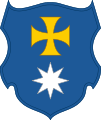 Coat of arms of the Myrhorod regiment of the Cossack Hetmanate (1625-1782)
Coat of arms of the Myrhorod regiment of the Cossack Hetmanate (1625-1782)
-
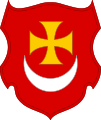 Coat of arms of the Borzna regiment of the Cossack Hetmanate (1648-1649)
Coat of arms of the Borzna regiment of the Cossack Hetmanate (1648-1649)
-
 Coat of arms of the Ichnia regiment of the Cossack Hetmanate (1648-1649)
Coat of arms of the Ichnia regiment of the Cossack Hetmanate (1648-1649)
-
 Coat of arms of the Braclav regiment of the Cossack Hetmanate (1648-1667)
Coat of arms of the Braclav regiment of the Cossack Hetmanate (1648-1667)
-
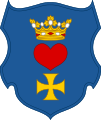 Coat of arms of the Kropyvna regiment of the Cossack Hetmanate (1649-1658)
Coat of arms of the Kropyvna regiment of the Cossack Hetmanate (1649-1658)
-
 Coat of arms of the Zinkiv regiment of the Cossack Hetmanate (1671-1782)
Coat of arms of the Zinkiv regiment of the Cossack Hetmanate (1671-1782)
-
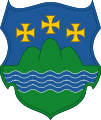 Coat of arms of the Bohuslav regiment of the Cossack Hetmanate (1685-1712)
Coat of arms of the Bohuslav regiment of the Cossack Hetmanate (1685-1712)
-
 Cossack flags preserved from the time of the Khmelnytsky uprising (1651)
Cossack flags preserved from the time of the Khmelnytsky uprising (1651)
-
 flag of the Kharkiv regiment of the Sloboda Cossacks (1651 – 1765)
flag of the Kharkiv regiment of the Sloboda Cossacks (1651 – 1765)
-
 flag of the Izium regiment of the Sloboda Cossacks (1688 – 1765)
flag of the Izium regiment of the Sloboda Cossacks (1688 – 1765)
-
 Flags and banners of the Black Sea Cossacks: 1) military banner of 1788; 2) banner of 1803, given by Alexander I; 3) kurin badges of 1788, donated by Catherine II)
Flags and banners of the Black Sea Cossacks: 1) military banner of 1788; 2) banner of 1803, given by Alexander I; 3) kurin badges of 1788, donated by Catherine II)
-
 Portrait of the Otaman Yakiv Kukharenko featuring Black Sea Cossack banners
Portrait of the Otaman Yakiv Kukharenko featuring Black Sea Cossack banners
-
 Emblem of the Ministry of Defence of Ukraine
Emblem of the Ministry of Defence of Ukraine
-
 Emblem of the General Staff
Emblem of the General Staff
-
 Emblem of the Defence Intelligence
Emblem of the Defence Intelligence
-
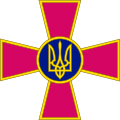 Emblem of the Ukrainian Armed Forces
Emblem of the Ukrainian Armed Forces
-
 Emblem of the Ukrainian Ground Forces
Emblem of the Ukrainian Ground Forces
-
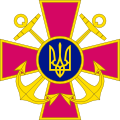 Emblem of the Ukrainian Navy
Emblem of the Ukrainian Navy
-
 Emblem of the Ukrainian Air Force
Emblem of the Ukrainian Air Force
-
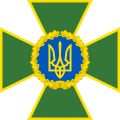 Emblem of the State Border Guard Service
Emblem of the State Border Guard Service
-
 Emblem of the Security Service of Ukraine
Emblem of the Security Service of Ukraine
Volhynia
See also: Volhynia-
 Coat of arms of the Volhynian Duchy (Principality)
Coat of arms of the Volhynian Duchy (Principality)
-
 Coat of arms of Volhynia with the Muscovite Monomakh's Cap
Coat of arms of Volhynia with the Muscovite Monomakh's Cap
-
 Volhynian Voivodeship in the Polish–Lithuanian Commonwealth
Volhynian Voivodeship in the Polish–Lithuanian Commonwealth
-
 Coat of arms of the Russian Volhynian Vice-royalty (Namestnichestvo)
Coat of arms of the Russian Volhynian Vice-royalty (Namestnichestvo)
-
 Coat of arms of Volhynian Governorate
Coat of arms of Volhynian Governorate
-
 Volhynian Voivodeship in Poland (1920-1939)
Volhynian Voivodeship in Poland (1920-1939)
-
 Coat of arms of Rivne Oblast
Coat of arms of Rivne Oblast
-
 Coat of arms of Zhytomyr Oblast
Coat of arms of Zhytomyr Oblast
Eastern Podolia
Poltava (Myrhorod Cross)
United Kingdom
University of Durham
-
 Coat of arms of the University of Durham
Coat of arms of the University of Durham
-
 Coat of arms of St Mary's College, Durham
Coat of arms of St Mary's College, Durham
-
 Coat of arms of St John's College, Durham
Coat of arms of St John's College, Durham
-
 Coat of arms of Ustinov College, Durham
Coat of arms of Ustinov College, Durham
-
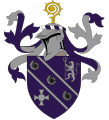 Coat of arms of the former College of St Hild, Durham
Coat of arms of the former College of St Hild, Durham
-
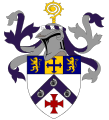 Coat of arms of the College of SS Hild and Bede, Durham
Coat of arms of the College of SS Hild and Bede, Durham
-
 Coat of arms of John Snow College, Durham
Coat of arms of John Snow College, Durham
-
 Coat of arms of South College, Durham
Coat of arms of South College, Durham
United States
-
 Southern Cross of Honor, used to honor Confederate Veterans
Southern Cross of Honor, used to honor Confederate Veterans
Other uses
| This section does not cite any sources. Please help improve this section by adding citations to reliable sources. Unsourced material may be challenged and removed. (November 2008) (Learn how and when to remove this message) |
The cross pattée is also placed before the name of the bishop who issues a Catholic imprimatur, and is occasionally found as a map symbol indicating the location of a Christian site.
It appears in the insignia of:
- The Victoria Cross
- The Distinguished Flying Cross (United States)
- The Bundeswehr Cross of Honour for Valour
- The Badge of Honour of the Bundeswehr
- The Order of St. George
- The Order "For Merit to the Fatherland"
- The Order of Bohdan Khmelnytsky
- The Order of the Dannebrog
- The Portuguese Football Federation
- F.C. Paços de Ferreira, a Portuguese football club
- C.F. Os Belenenses, a Lisboeta football club
- Casa Pia A.C., a Portuguese sports association
- Mira Mar SC, a Portuguese football club
- CR Vasco da Gama, a Brazilian sports club
- Vasco da Gama (South Africa), a South African sports club
- Flag of Asturias, a Spanish Principality
- Toulouse FC, a French football club
- The Sir Knight, Geneva Glen Camp's Highest rank in the orders
- The Knights of Columbus, designed in 1883, and called a "cross formée"
- Independent Truck Company, a manufacturer of skating equipment (in the alisée form, with the ends of the arms in the shape of arcs of an enclosing circle)
- The Crossmen Drum and Bugle Corps
- Schneider Cams, a speed equipment manufacturer
- Neath RFC, a Welsh rugby club
- The Eaton House Group of Schools
- FC Volyn Lutsk, a Ukrainian football club
- Black Label Society, a heavy metal band
- Flag of the Hispanic People
- The Fifth Corps, a unit of the Union Army of the Potomac during the American Civil War from 1862–1865.
Firefighters, especially in the United States, commonly use a version with triangular arms for patches and medals, though the cross pattée and the cross of St. Florian are both commonly mistaken for the Maltese cross. The cross pattée is used on the Marksmanship Badge in the United States Army, and United States Marine Corps.
Encoding
In Unicode, a Cross pattée character is encoded under the name "Maltese Cross" in the Dingbats range at code point U+2720 (✠).
The character "X" is rendered as a cross pattée in the Microsoft Wingdings font.
See also
References
- Larousse Dictionnaire de la Langue Francaise Lexis, Paris, 1993, p.1356
- Planché, J.R. The Pursuivant of Arms; or Heraldry Founded upon Facts. London, 1859, p.29
- Davies, Nikolas; Jokiniemi, Erkki (2012). Dictionary of Architecture and Building Construction. Routledge. p. 104. ISBN 9781136410253.
- ^ "PATTÉ : Définition de PATTÉ". Centre National de Ressources Textualles et Lexicales. 2012. Archived from the original on 2023-08-11. Retrieved 2023-08-11.
- Koch, Rudolf (1955). The book of signs. New York: Dover Publications. ISBN 9780486201627. OCLC 509534.
- Healey, T. (1977). The Symbolism of the Cross in Sacred and Secular Art. Leonardo, 10(4), 289-294. doi:10.2307/1573764
- "Arms & Badges - Royal Arms of Canada, A Brief History". www.heraldry.ca.
- Defence, National (November 2, 2018). "Canadian Medals Chart". aem.
- Cetinje, Official website (English). "Symbols". Retrieved 18 April 2014.
- Derevyanko, Kolesnikov. "Awards: Rewarded With A Battle Order", Bratishka, Feb 2002
- Goncharov, 2010, Award System of the Russian Federation
- Samoilov, 2021, "Military Expert Explains the Symbolism of the Trench Cross", Politnavigator
- Nationalencyklopedin, "Georgskors", retrieved 12 August 2010. Swedish.
- Norrgård, Leif (2009-02-18), "Frimurarkorset – symbol med dunkelt ursprung", Frimuraren (in Swedish), no. 1, Swedish Order of Freemasons, pp. 31–32, 1651-35766, archived from the original on 2016-08-18, retrieved 3 February 2015.







